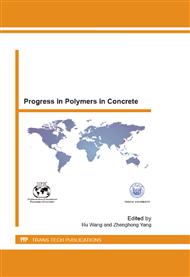p.426
p.430
p.435
p.443
p.449
p.456
p.461
p.466
p.472
The Adsorption of Superplasticizers on Cement Particles and its Relation with Dispersibility
Abstract:
The dispersing effect of superplasticizer is closely related to its adsorption behaviors on the surface of cement particles or the hydrates. But the relationship between the adsorption amount of superplasticizer and the fluidity of cement paste seems uncertain. To investigate the relationship between the adsorption amount and the fluidity of cement paste, three groups of cements with designed compositions and C3A mineral were prepared in lab. Four types of superplasticizer were used to measure the adsorption on various cements. The corresponding zeta potential of cement particles with superplasticzers and the fluidity of cement pastes were tested and analyzed. It was found that the adsorption amount of superplasticizer was inversely related to the fluidity of cement paste for a given superplasticizer. The zeta potential of cement particles in the paste was proportional to the adsorption amount of superplasticizer. The adsorption amount of different superplasticizers at the isoelectric point in C3A-H2O system was determined. The meaning of the “adsorption amount” was discussed. The author proposed that the superplasticizer in cement paste should include three parts, and the role of each part was discussed according to test results and analysis.
Info:
Periodical:
Pages:
449-455
Citation:
Online since:
April 2013
Authors:
Keywords:
Price:
Сopyright:
© 2013 Trans Tech Publications Ltd. All Rights Reserved
Share:
Citation:


